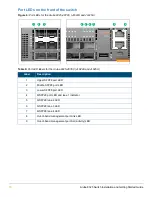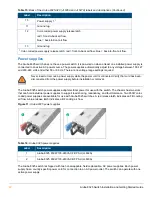
28
Aruba 8325 Switch Installation and Getting Started Guide
Installation procedures
Summary
1. Prepare the installation site (page 30).
Ensure the physical environment into which you will be installing the
switch is properly prepared, including having the correct network cabling ready to connect to the switch and
having an appropriate location for the switch. See
“Installation precautions” on page 29
for some guidelines
on avoiding personal injury or product damage when installing your switch.
2. Install power supplies (page 30).
Install power supplies if they are not already installed.
3. Install fan assemblies (page 31).
Install fan assemblies if they are not already installed.
4. Power on the switch and check LEDs (page 32).
Power-on the switch and check the LEDs for proper switch
operation.
5. Power off the switch (page 34).
Remove power from the switch.
6. Mount the switch (page 34).
The switch can be mounted in a 19-inch telco rack or in an equipment cabinet.
7. (Optional) Install transceivers (page 37).
The switch has slots for installing SFP+/SFP28 and QSFP+/
QSFP28 transceivers. Depending on where you install the switch, it may be easier to install the transceivers
first. Transceivers can be hot swapped—they can be installed or removed while the switch is powered on.
8. Connect power to the switch (page 40).
Once the switch is mounted, plug it into the main power source.
9. Connect a management console to the switch (page 41).
You may want to modify the switch’s
configuration, so it can be managed using a Web browser or through an SSH or Telnet session. Configuration
changes can be made by using a console cable to connect a PC to the switch’s console port.
10. Connect the network devices (page 43).
Using the appropriate network cables, connect the network devices
to the switch ports.
At this point, your switch is fully installed. See the rest of this chapter if you need more detailed information on any
of these installation steps.






























